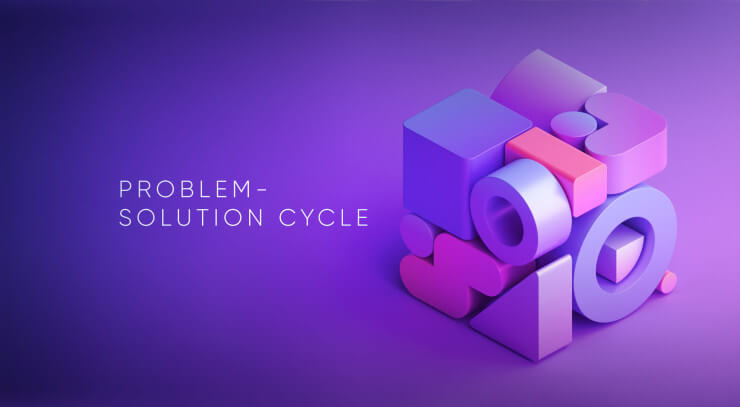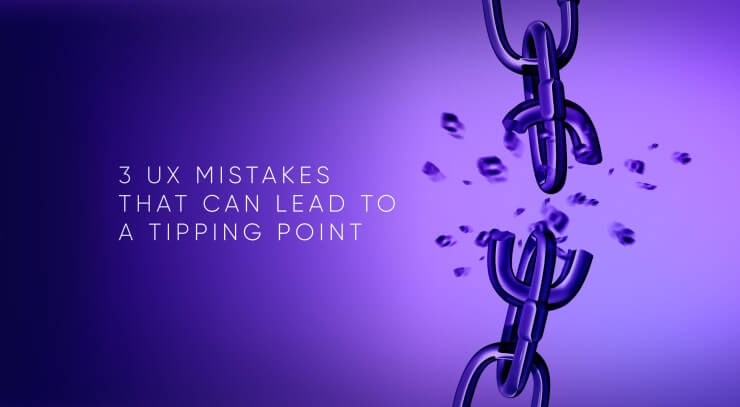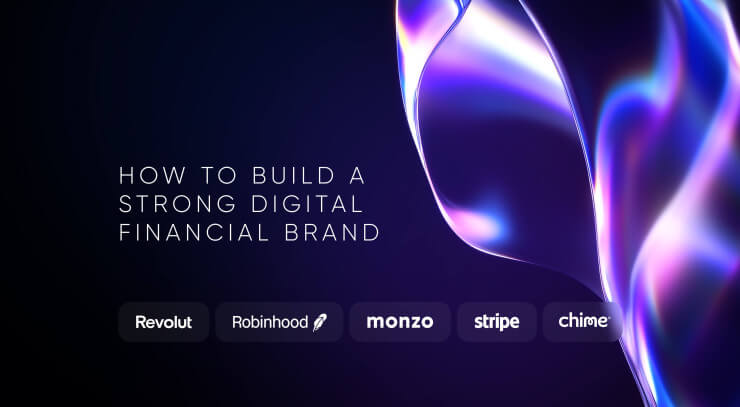A digital bank design is a labyrinth of complexity, regulations and high stakes. Despite the allure of high-profile projects and substantial budgets, even the most skilled designers often hesitate to delve into this demanding sector. The cost of hiring a top fintech UX design agency could be very high. The primary reason? The consequences of design flaws in financial services can be catastrophic, ranging from millions in losses to severe breaches of customer trust, and this could ruin even a top designer career.
Recently, I had an insightful conversation with the head of a financial company who posed a familiar question: "How much does it cost for UXDA to fully design and finish a mobile banking app?" This query, while common, misses the broader picture.
I explained, “This is the wrong question. Asking about the cost of finishing a mobile banking app is akin to asking what specific exercise you should do to become strong or how many books you should read to become smart. Everything depends on your lifestyle and on your daily routine. So, the key to delivering the best digital experience is always an ongoing investment.”
A basic mobile banking app can be designed and proceed to development in six months with an initial investment of around $300,000, with more complex solutions potentially exceeding one year and $1 million. However, this is merely the starting point. Continuous investments are essential for maintaining and enhancing the user experience.
A digital bank is not a branch that can be built and left alone for 10 years. For example, banks and Fintechs served by UXDA have average monthly budgets of around $50,000 on UX design. Look at Apple’s strategy: they update their products daily, and major upgrades are released every six months. If we agree that banks are also becoming technology companies, they will have to follow a similar product approach or go out of business in a decade.
Surprised, he remarked, "Wow! A million just for design? I thought it usually costs around $50,000!"
I smiled and clarified, “In many cases, banks spend nothing on UX and design, relying on vendors’ white-label design. And yes, it’s possible to deliver a bank app design for $50,000 by adapting a $100 UI template to the basic functionality and bank’s colors. But the real question is: who is ready to invest millions in digital transformation and innovative service infrastructure to deliver it to customers through a $50,000 copycat UI design?”
Currently, banking services are moving away from brick-and-mortar branches. The majority of customers will never meet bank employees or visit a bank branch in a decade. The only experience they will have with a bank is through the digital bank app because customers are no longer forced to meet bank tellers if all banking services are delivered well. This means that digital financial products—such as banking apps, online banking, immersive banking, wearable banking, insurance services and investment platforms—serve as the primary connection between the bank and its customers. Therefore, the bank's focus should be on ensuring that these digital experiences are enjoyable and competitive.
So, the real truth is that a financial digital product isn't just another delivery channel anymore for modern customers, it's the bank itself. Nowadays, the financial digital product encompasses various services and heavily influences the customer experience, brand perception and market position. Properly designing a user experience for this digital product is not a simple task. It requires extensive research, testing, iterations and a deep understanding of user experience and financial technology.
For a billion-dollar banking or financial business with millions in profits, skimping on the design of its main product is perplexing. Saving on financial product UX design and architecture is like participating in Formula 1 with a $30,000 Toyota Corolla and expecting it to compete with $15 million race cars. Both are vehicles, both have wheels, an engine, a steering wheel and a brake. But these cars serve vastly different purposes and are designed with different expertise and materials. For the Formula 1 team, their tailor-made sports car is their business, and they constantly invest in competitive advantages, fighting to win by even one more second.
Nightmare of designing financial services
Have you heard of the elite category of service designers? These are special forces in the design industry capable of solving any problem. These are the top designers, who combine exceptional skills, deep industry knowledge and innovative thinking with a successful project track record. They master design tools and techniques, continually updating their skills to stay ahead. Known for creative solutions, their work sets new trends and standards.
They deeply understand UX principles, creating digital service designs that are visually appealing, functional and user-friendly, blending creativity with analytical thinking. They understand the psychological and emotional aspects of design, creating products that meet functional and business needs while resonating with users. Their portfolio showcases successful projects, influencing and shaping the future of design.
And everything mentioned above is the exact reason why top designers often refuse to design financial services─because they know all too well that financial service design requires a deep understanding and experience with financial platforms and technology, user behavior and regulatory compliance.
Unfortunately, we’ve seen countless financial digital product designs created by non-professional designers fail to meet the critical requirements of financial services. These poorly designed financial digital products are not only awful but potentially dangerous. Do you remember the confusing bank interface behind Citigroup's $500 million mistake? Or the ‘fat finger’ error that led to £1.1bn of mistaken orders?
Top designers critically assess their own capabilities and are well aware of financial service design challenges that can turn a job into a nightmare:
- Extra Responsibility: A digital bank design carries a high level of responsibility because mistakes can lead to significant financial losses and a decrease in trust, even in well-established and financially successful banks. An incorrect design decision can result in security vulnerabilities, data breaches or regulatory non-compliance, costing banks millions and damaging their reputation.
- Understanding Financial Terminology: Financial services involve complex terminology and concepts that non-specialized designers might not fully grasp. This lack of understanding can lead to miscommunication, misinterpretation of requirements and, ultimately, flawed designs that fail to meet user needs or regulatory standards.
- Extreme Complexity: The financial industry is one of the most complex sectors, with intricate systems, numerous interconnected processes and a vast array of products. Designers need to keep a conceptual model of these complexities in mind to create effective and intuitive interfaces.
- Business Context: Understanding the inner processes of banks and financial institutions is crucial. There are always many restrictions and specific ways to do things. A lack of sufficient knowledge in these processes can lead to numerous iterations and updates at best and, at worst, result in a final product that is not regulatory compliant.
- Legal and Regulatory Compliance: Financial services are heavily regulated. Designers must ensure that their digital bank design complies with various legal and regulatory requirements, which can be intricate and vary by region. Non-compliance can lead to legal penalties and loss of user trust.
- Digital Specifics: Financial technology evolves rapidly, and designers must stay up-to-date with the latest innovations and security standards. Without this knowledge, designers risk creating outdated or insecure solutions that do not meet user expectations or industry requirements. At the other end, many financial institutions rely on legacy or vendor systems, and designers must create modern user-friendly interfaces that integrate seamlessly with these older systems, which can be technically challenging and time-consuming.
- Collaboration Specifics: Financial service projects are typically large scale and involve extensive collaboration with dozens of stakeholders. Designers need to manage these collaborations effectively, ensuring clear communication, setting priorities and aligning the project with business goals.
- Scalability and Performance: Financial services are accessed across multiple devices, so ensuring a consistent and seamless experience across all devices is essential. Also, financial services requires a scalable design system that can handle long-term development and continual product improvements, which adds another layer of complexity.
- User Behavior Specifics: Financial services have unique usage patterns and usability standards that differ from other services. Understanding these specifics requires experience and competence in the financial sector. Designers must account for how users interact with financial products and their expectations for reliability and security. Financial decisions are often emotionally charged, so designers must create interfaces that are not only functional but also empathetic.
- Pre- and Post-Launch Support and Validation: The digital bank design process does not end with the delivery of design assets. Designers need to support the integration of their designs into development, assist with the launch process and continue to iterate and improve the product based on user feedback and evolving needs. Before launch, financial interfaces must undergo rigorous testing to ensure they meet high standards of security, performance and usability. This involves extensive user testing, security audits and iterative improvements, making the design process longer and more complex.
- Data Visualization: Financial services heavily rely on data visualization to convey complex information clearly and accurately. Designers must be adept at creating intuitive visualizations that make sensitive financial data comprehensible and actionable for users, preventing misunderstandings and ensuring accurate decision-making. This means that designers must understand financial data even better than the product owners in order to translate it into the language of users.
The trap of the “I can handle anything” approach
There is also another opposite breed of designers and agencies that present themselves as masters of all trades. Whether it’s a global digital agency, a local design studio, business consultancy, a freelancer or even an in-house employee, these "I can handle everything" professionals claim expertise across all sectors. From flower e-shops and medical clinic homepages to government service portals and banking platforms, they promise top-notch designs for any imaginable digital service.
Their confidence is palpable. They market themselves aggressively, are quick to agree to all conditions and often win tenders and contracts through sheer assertiveness and the lowest price. This readiness to take on diverse projects makes them fantastic tender hunters and adept cold sellers. But when it comes to the intricate world of financial services, this jack-of-all-trades approach can lead to disastrous results.
One might wonder: Why do top designers hesitate while less experienced generalist agencies jump right into action? The answer lies in the intricate balance required in a digital bank design—a balance between usability, security and regulatory compliance. With deep background, experience and competence, top designers understand the high stakes involved. They know that the work will be difficult, and a minor oversight can lead to catastrophic results—from data breaches to user frustration and financial loss.
Generalist agencies, on the other hand, may not fully grasp the complexities and potential pitfalls of designing for financial services and don’t worry too much about time needed to understand the product and the quality of the end result. They often agree to take on these projects without a deep understanding of what they entail. This lack of awareness can lead to poorly designed interfaces that frustrate users and fail to meet stringent security standards. Consequently, financial institutions frequently turn to specialized agencies like UXDA to completely overhaul these subpar designs.
Oddly enough, it is not obvious to many. Once a bank came to us and asked: "Will your agency have enough time to figure out our service in 2 months? Because the previous design agency took 4 months only to explore our product." Imagine their surprise when, a month later, they received the architecture of their new service from us!
At the end of the day, it all depends on how high the stakes are. For example, if a heart operation is needed, will a person go to a general surgeon who treats everything and everyone, or will they opt for a cardiac surgeon with extensive experience and specialization?
Specialized UX designers bring a depth of knowledge, efficiency and expertise to their industry that generalist designers typically cannot match. Their ability to handle complex requirements, ensure regulatory compliance and create user-centered, secure and innovative solutions makes them invaluable for financial service projects. Let's explore the key differences between generalist designers and specialized financial service design experts:
1. Domain Expertise
Generalist Designers:
They lack the specific knowledge required to understand and design for financial services. They often need additional time to learn and understand financial terminologies and regulatory requirements, which can delay the project. They risk creating designs that may not fully comply with industry regulations, potentially leading to costly revisions or legal issues.
Specialized Financial UX Designers:
They possess a deep understanding of the financial sector, including its unique requirements, terminologies and complexities. They can effectively translate complex financial concepts into intuitive designs that meet user needs and expectations. Their familiarity with financial user behavior helps them create interfaces that are easy to navigate and understand, even for users with limited financial literacy.
2. Design Complexity Management
Generalist Designers:
They struggle with the high complexity and specific requirements of financial services. They may produce designs that are either too simplistic, missing critical functionalities, or overly complex, causing user frustration. They often lack the experience to balance usability with the sophisticated needs of financial systems.
Specialized Financial UX Designers:
They are adept at managing the complexity of financial services, including intricate workflows and interconnected systems. They can design interfaces that handle high transaction volumes and ensure data accuracy, critical for financial applications. They create solutions that simplify complex financial processes for users, enhancing usability without sacrificing functionality. By providing a seamless, intuitive and secure user experience, they increase customer satisfaction and loyalty.
3. User-Centered Design Approach
Generalist Designers:
They do not fully understand the unique behaviors and needs of financial service users and risk designing interfaces that fail to engage users emotionally or address their specific financial concerns. They may not anticipate critical user scenarios specific to financial services, leading to gaps in the user experience.
Specialized Financial UX Designers:
They have a thorough understanding of financial user behavior and can design intuitive, user-friendly interfaces that cater to various user segments. They use insights from financial psychology to create emotionally engaging and trustworthy experiences. They can design for specific user scenarios unique to financial services, such as onboarding, financial transactions and personal finance management. They focus on delivering a seamless and intuitive user experience tailored to the specific needs of financial service users.
4. Efficiency and Project Management
Generalist Designers:
They may lack the refined processes required for large-scale financial projects, leading to inefficiencies and potential delays and often struggle with managing extensive collaborations, which can result in miscommunications and misaligned priorities. They typically do not offer ongoing support post-launch, which can affect the long-term success and optimization of the product.
Specialized Financial UX Designers:
They have established processes and best practices for handling financial service projects, leading to more efficient project execution. They can clearly communicate complex design concepts and requirements to various stakeholders, ensuring everyone is aligned. Their experience with large-scale financial projects enables them to manage timelines, set priorities and coordinate efforts efficiently. They provide comprehensive support throughout the project lifecycle, from pre-launch to post-launch, ensuring continuous improvement.
5. Innovation and Security
Generalist Designers:
They might not be as familiar with the latest financial technology innovations, leading to potentially outdated solutions. They may overlook critical security aspects, increasing the risk of data breaches and compromising user trust. They often react slower to new trends and technological advancements, which can affect the competitiveness of the financial product.
Specialized Financial UX Designers:
They stay updated with the latest innovations in financial technology, ensuring that their designs are future-proof, user-centered and competitive. They are aware of the latest security standards and incorporate robust security features into their designs to protect sensitive financial data. They can quickly adapt to new trends and technologies, providing forward-thinking solutions that keep the financial institution ahead of the curve. They continuously refine and update designs based on user feedback and technological advancements, maintaining the relevance and effectiveness of financial applications.
The UXDA approach that brought us 150 financial products
Ultimately, the value of a solution is determined by its ability to meet desired results, not just its costs. If you want a private house, a standard blueprint might suffice. But if you're building commercial real estate, you're designing a business, not just a space, and doubling the investment into architecture will lead to tripling the profit.
Why would a bank settle for a cheap copycat app that fails to meet strategic business goals, satisfy users, outperform competitors, grow the business and protect its billion-dollar digital investment? Saving half a million and risking billions in the long term isn’t a sensible strategy. That’s why UXDA experts, just like Formula 1 engineers or skyscraper architects, use advanced design techniques and spend months to tailor financial applications to the complex, unique and controversial needs of banks and their customers.
The UXDA team knows too well how such a deeply-concentrated approach to user experience (UX) design, dedicated solely to the financial industry, can yield substantial benefits for clients. Our narrow domain and design focus is essential to translate digital solutions into tangible advantages for financial institutions:
- Competence and Experience.
While designing over 150 financial products in 37 countries, UXDA's specialization provides a depth of competence and experience no other agency can provide. Every UXDA consultant possesses rich product design experience, a strong financial background and advanced expert degrees. This unique blend helps us to stay at the forefront of industry trends, understand user psychology and effectively navigate the complexities of the financial sector. Speaking the same language as financial executives fosters seamless communication and alignment with client goals. - Tailored Methodology.
A focused UXDA approach enables the development of methodology specifically tailored to the financial sector. UXDA's crafted methodology addresses the unique needs and challenges of financial services. Our tailored approach ensures that the solutions are not only effective but also compliant with industry standards and regulations. - Proven Credibility.
Focusing on a single domain builds UXDA’s credibility. UXDA’s insights have been acknowledged by over 300,000 financial specialists and have been featured in top publications, such as Forbes, Finextra, The Financial Brand and dozens of other media outlets. This recognition is a testament to our experts' influence and contribution to the financial industry. - High Satisfaction and Recommendations.
UXDA specialization leads to higher client satisfaction and recommendations. UXDA’s exclusive focus on finance has resulted in 87% of our clients being highly satisfied and willing to recommend our services. Such high satisfaction rates are indicative of the quality and effectiveness of our tailored solutions. - Strategic Alignment and Dedication.
A focused UX design partner aligns its strategies with the financial brand’s mission, identity and goals. UXDA’s strategy-driven approach ensures that every product design is optimized to contribute to the business objectives and long-term strategy of the financial institution. Our dedication solely to financial services, with no internal competition from other sectors, guarantees a high level of commitment and quality. - Award-Winning Designs and Global Reach.
Specialization often leads to excellence and recognition. UXDA’s design quality has been recognized by 27 awards, including top product design awards such as Red Dot and iF awards. Our global reach, with over 150 financial services designs delivered to 37 countries, showcases the UXDA team’s ability to cater to diverse markets and maintain high standards universally. - Reducing Risks.
Focusing on a specific industry also reduces risks. UXDA’s expertise minimizes the likelihood of critical mistakes that could cost millions in financial losses and damage to customer loyalty and trust. Our specialized knowledge ensures that projects are managed efficiently, avoiding common pitfalls associated with generic and copycat design approaches. - Long-Term Success and High ROI.
A specialized approach not only ensures immediate benefits but also contributes to long-term success. UXDA’s solutions are designed to be future-proof, aligning with the latest trends and best practices. This strategic optimization leads to better user experiences, higher revenue, faster onboarding and quicker time to market, ultimately boosting ROI and ensuring sustained competitive advantage.
Conclusion: specialization is a must in finance
When non-specialized designers tackle financial projects, the results are often subpar and sometimes even dangerous. Poor digital bank design can confuse users, lead to incorrect transactions and result in expensive errors.
Moreover, these inadequately designed digital products often result in high customer dissatisfaction and attrition rates. Users expect financial services to be reliable, intuitive and secure. When these expectations are not met, they quickly lose trust and seek other alternatives, causing significant losses for financial institutions.
Generalist designers may fail to grasp the specific needs and behaviors of financial digital product users. For example, users may struggle to navigate and understand the app, leading to frustration and errors during transactions. Poor UX often leads to higher volumes of customer support inquiries, increasing operational costs and burdening support teams.
A poorly designed financial digital product can significantly impact customer perception and trust. Security concerns, frequent errors and poor usability can erode trust in the financial institution, causing users to seek alternative services. Frustrated users are likely to switch to competitors who offer more reliable and user-friendly financial digital products, leading to a loss of customers and revenue.
Inadequate digital bank design can affect the efficiency of financial operations. Poor UX can lead to higher rates of user errors, which require additional resources to rectify and can delay transaction processing. Post-launch issues often require significant redesign and development efforts, leading to increased costs and delayed project timelines.
The high stakes of financial services design make it a domain where specialization is not just beneficial but essential. While “I can handle everything” designers may excel in diverse fields, the high stakes and unique demands of financial UX design require a focused and expert approach. Financial institutions must recognize the importance of specialized designers to create secure, effective and user-friendly financial products that inspire trust and drive success.
Specialized financial UX designers bring a wealth of knowledge and experience that generalists lack. They understand the intricacies of financial systems, user psychology and regulatory environments. Their expertise ensures that designs are not only visually appealing but also secure, functional and aligned with the financial institution's strategic goals.
To determine if designers are appropriate for financial services, it's crucial to ask targeted questions that reveal their experience, expertise and capability in handling the specific demands of financial UX design. Here are some essential questions checklist to consider:
1. How many financial digital products have you designed?
Look for a specific number and details about the types of financial products (e.g., banking apps, investment platforms, insurance services).
2. Can you provide examples of your work in the financial sector?
Ask for a portfolio showcasing their financial UX design projects.
3. What are your largest financial clients and what have you delivered?
Inquire about notable clients to gauge their experience with major financial institutions and their scope of work.
4. What challenges have you faced in designing financial products, and how did you overcome them?
This will reveal their problem-solving skills and understanding of financial UX complexities.
5. How do you stay updated with the latest trends and regulations in financial services?
Ensure they are proactive in keeping their knowledge current.
6. How many expert publications on financial UX design have you been in? Can you provide links to your articles or presentations?
Publications indicate a deeper involvement and thought leadership in the field, use Google Search to check it out.
7. Can you share testimonials or references from your financial clients?
Client feedback provides insight into their performance and client satisfaction.
8. What is your design process when working on a financial project?
Look for a structured approach that includes user research, regulatory compliance, security considerations and iterative testing.
9. How do you handle collaboration with large teams and multiple stakeholders?
Effective communication and project management skills are crucial for large financial projects.
10. What kind of support do you provide post-launch?
Ongoing support is essential for addressing issues and making continuous improvements.
11. What tools and technologies do you use for financial UX design?
Their proficiency with industry-standard tools and technologies is critical for delivering high-quality designs.
12. Can you provide examples of innovative solutions you’ve implemented in financial products?
Innovation is key to staying competitive in the rapidly evolving financial sector.
13. Can you walk me through a case study of a financial project you led?
A detailed case study will provide insights into their approach, execution and outcomes.
14. How do you incorporate user feedback into your financial designs?
User feedback integration is crucial for continuous improvement and user satisfaction.
Get UXDA Research-Based White Paper "How to Win the Hearts of Digital Customers":
 If you want to create next-gen financial products to receive an exceptional competitive advantage in the digital age, contact us! With the power of financial UX design, we can help you turn your business into a beloved financial brand with a strong emotional connection with your clients, resulting in success, demand, and long-term customer loyalty.
If you want to create next-gen financial products to receive an exceptional competitive advantage in the digital age, contact us! With the power of financial UX design, we can help you turn your business into a beloved financial brand with a strong emotional connection with your clients, resulting in success, demand, and long-term customer loyalty.
- E-mail us at info@theuxda.com
- Chat with us in Whatsapp
- Send a direct message to UXDA's CEO Alex Kreger on Linkedin






















